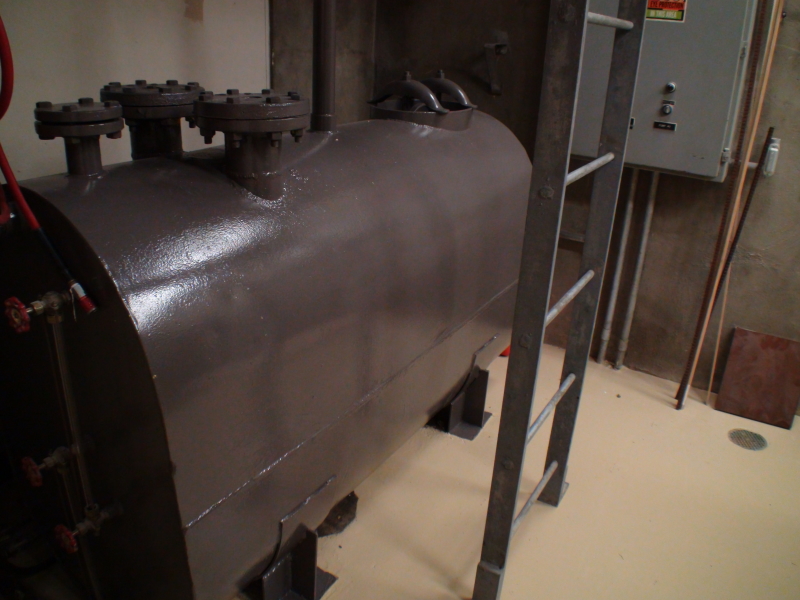Don’t let a diesel leak go undetected!
(or water … or hydraulic oil … or battery acid)
Diesel powered generators and pumps are extremely reliable. They don’t require much attention and may go weeks between test runs. Without daily checks ,a leak can go undetected for quite a while and that leads to two types of risk: fire acceleration and off site environmental damage.
Fires involving diesel spills are rare but potentially catastrophic — Diesel fuel by itself is unlikely to start a fire, but if a fire starts from another cause, an undetected puddle of fuel will cause the fire to burn hotter and faster than most sprinkler systems can contain.
Off site fuel contamination is a far more frequent outcome — “Leak detection by neighbors” is never a good way to learn that your day tank is leaking. And if the leaking fuel finds its way to a storm drain and to nearby water features, the cost of clean-up, potential fines and bad press gets very expensive.
Already know what you need: Visit the DFS-3 Online Store
Industry Guidance & Safety Considerations
Factory Mutual has taken the lead on the fire safety front. Since they insure buildings, they publish standards and guidance to mitigate risk (and their potential loss.) In fact, FM publishes strongly worded safety guidance for facility managers who are responsible for diesel generators:
“Provide automatic leak detection in the main fuel storage tank room/vault, fuel pump room/vault, and on the generator room floor in diked areas surrounding day tanks. Additionally, provide leak detection within all double-walled piping systems and in all pipe chases/shafts. Arrange the leak detection to automatically shut off the flow of fuel and sound an alarm at a constantly attended location. This may be accomplished by interlocking the leak detection with a safety/emergency shutoff valve.”
But any news search for “diesel fuel leak”, will turn up far more examples of environmental damage than fires. Fires are costly but they are rare. Off-site damage occurs multiple time every year, all over the world.
- Sherman Williams leaks 100 gallons of diesel into the Cuyahoga River
- State of Illinois leaks hundreds of gallons of diesel into lake
- City of Germantown pumps 300 gallons of fuel into water aquifer
- Alberta company leaks 1000 liters of fuel into lake
Simple, effective leak detection is very affordable and addresses both risks. If you already have a BMS or facility monitoring system, adding diesel leak detection to your diesel generator installation can cost as little as US$ 300.00
TRM-DFS-3 and TRM-Easy5 smart relays have been independently tested to US EPA 3rd party leak detection test protocols, and are listed in the data base of the National Working Group on Leak Detection Evaluations. (NWGLDE)
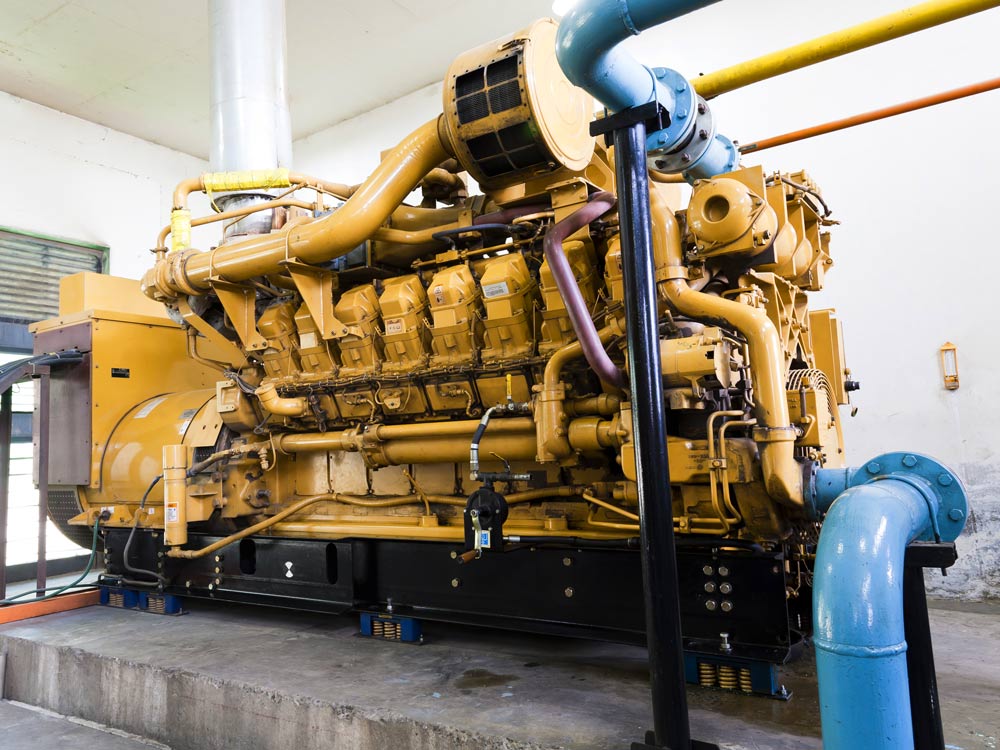
Sensors for indoor applications:
TRM Sensors’ Diesel Fuel Sensors (TRM-DFS-3)
Meet the TRM-DFS-3 Diesel Fuel Sensor. These are compact, low center of gravity sensors that can sit directly on a concrete floor or in a drip pan directly below equipment or fittings that can be the source of a fuel leak. Place TRM-DFS-3 under day tanks, below filter canisters, under flex couplings and near pumps or valve-manifolds. An accessory TRM-DFS-3-SSHD hold down can be used to fix the sensor in place while allowing for tool free inspection and service.
To protect against leaking fuel reaching the building drainage system, a TRM-DFS-3 can be positioned to guard the floor drain or a TRM-CC can be mounted in a sump to detect fuel reaching the sump floor or floating on the surface of any collected water.
For most BMS or PLC input cards, a single TRM-DFS-3 appears to be Normally Closed dry contact that opens on alarm. In many cases a TRM-DFS-3 can be connected to an input on the nearest Building Management System input panel. Or, when more than one TRM-DFS-3 is deployed, multiple sensors can be daisy-chained to a single TRM-Easy5-Relay-U, TRM-Easy5-SDR or a TRM-Easy5-Panel. If any one of the sensors detects a fuel leak, an alarm signal is generated for BMS input or to an audible alarm in a remote security office.
TRM Sensors’ Water and Coolant Sensor (WLS)
Need to monitor your diesel engine for water/glycol coolant leaks? The TRM-WLS Water Leak Sensor is the solution. These are compact, low center of gravity sensors that can sit directly on a concrete floor or in a drip pan directly below water/glycol cooled equipment.
These sensors are a compliment to the TRM-DFS-3 diesel sensor. For many diesel engine installations, knowing that coolant is leaking is just as important as detecting a fuel leak.
Here is the bonus: Because this TRM-WLS coolant sensor was designed as a compliment to the TRM-DFS diesel fuel sensor, a single TRM-Easy5-Relay-U, TRM-Easy5-SDR or TRM-Easy5-Panel can monitor both sensors simultaneously. In fact one TRM-Easy5-Relay or Panel can monitor up to 10 of the TRM-DFS-3 fuel sensors and up to 10 of the TRM-WLS water/coolant sensors at the same time.
TRM Industrial Oil Sensor (IOS)
TRM-IOS detects non-volatile oils used for insulation, heat transfer, lubrication or mechanical force. Hydraulic oil, mineral oil (transformer oil), vegetable oil and clean lube oil are examples.
Oils that are refined to be inert are not easy to detect. Fuel sensors (e.g. TRM-DFS-3) exploit the volatile hydrocarbons but the volatile components are intentionally removed from most industrial oils. Consequently probes and cable designed to detect fuel are very slow to respond to oil* (if they respond at all).
Like all other probes manufactured by TRM Sensors, the TRM-IOS is a passive resistive sensor. It qualifies as “simple apparatus” per IEC 60079-11. When it is clean, the sensor element has a low resistance which changes to a very high resistance within a few seconds after contact with most oils. In many ways the TRM-IOS is analogous to a soft off/on switch that is normally on and opens on alarm. But that analogy isn’t perfect. The current carrying capacity of the sensor element is low and the “on” resistance is much higher than that of a mechanical contact. TRM-IOS is normally monitored by TRM-Easy5-Relay /Panel that has been programmed to anticipate the sensor’s response parameters.
The TRM-IOS sensor element can be quickly swapped out with a replacement element. No tools are needed. Because the target oils are non-volatile, they don’t evaporate and the sensor elements should be thought of as “one use”. Each TRM-IOS ships with one sensor element installed and two spare replacement elements.
- “Oil” used in context of IOS refers to refined, synthesized and manufactured products. Crude Oil falls into the fuel category since it contains a significant fraction of volatile components. Use TRM-DFS-3 or TRM-CC for crude oil application”
“Any Liquid” Optical Probes
TRM-ALOS is a recent addition to the TRM Sensors line-up. In some situations any liquid in an area that should be dry is cause for alar. Elevator pit monitoring is an excellent example. The pit should be dry at all times but water leaking in from cracked foundations or hydraulic oil leaking from a damaged shaft seal deserves immediate attention. It doesn’t matter what type of liquid is present. Fast detection and timely maintenance attention is the objective in either case.
The TRM-ALOS is an optical probe, mounted in sturdy hockey puck sensor body. The sensor is designed so that the probe is position just above the floor level so that only a very shallow puddle ( ~ 1 mm ) is required to activate the alarm. Reset is immediate when the sensor is lifted out of the liquid and the probe can be reused indefinitely as long as it is not physically damaged. There are no moving parts, metal components or exposed circuitry to corrode.
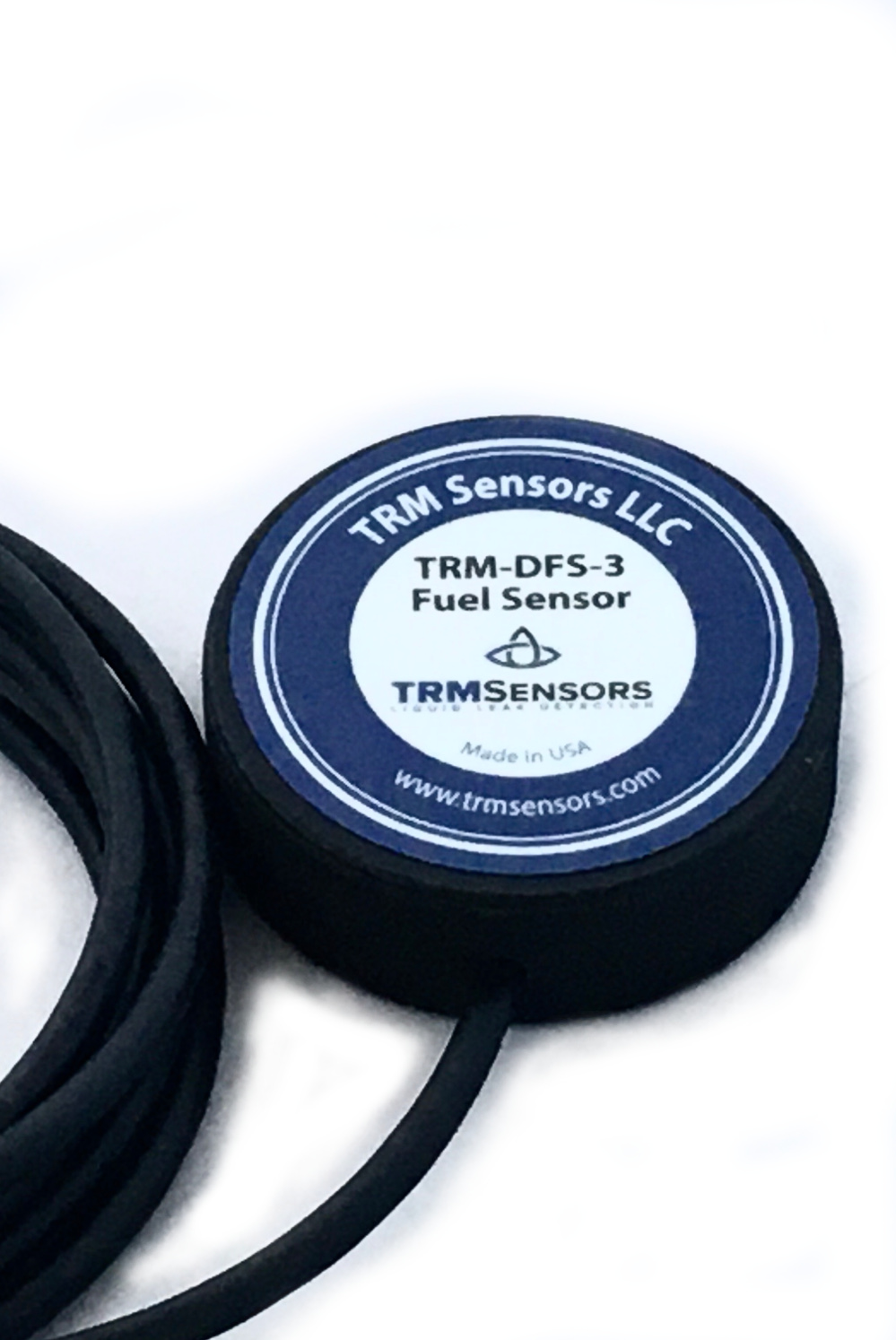
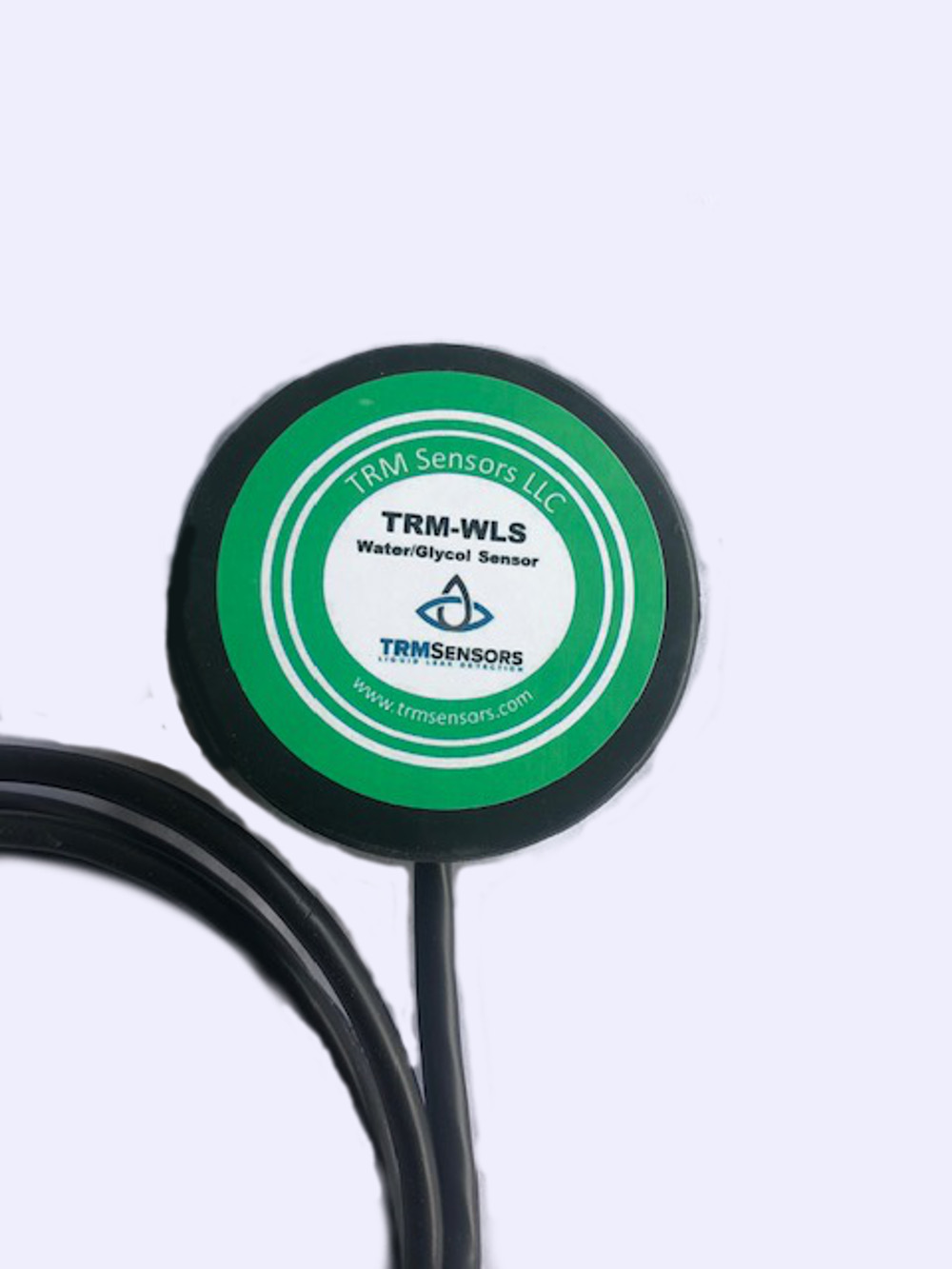
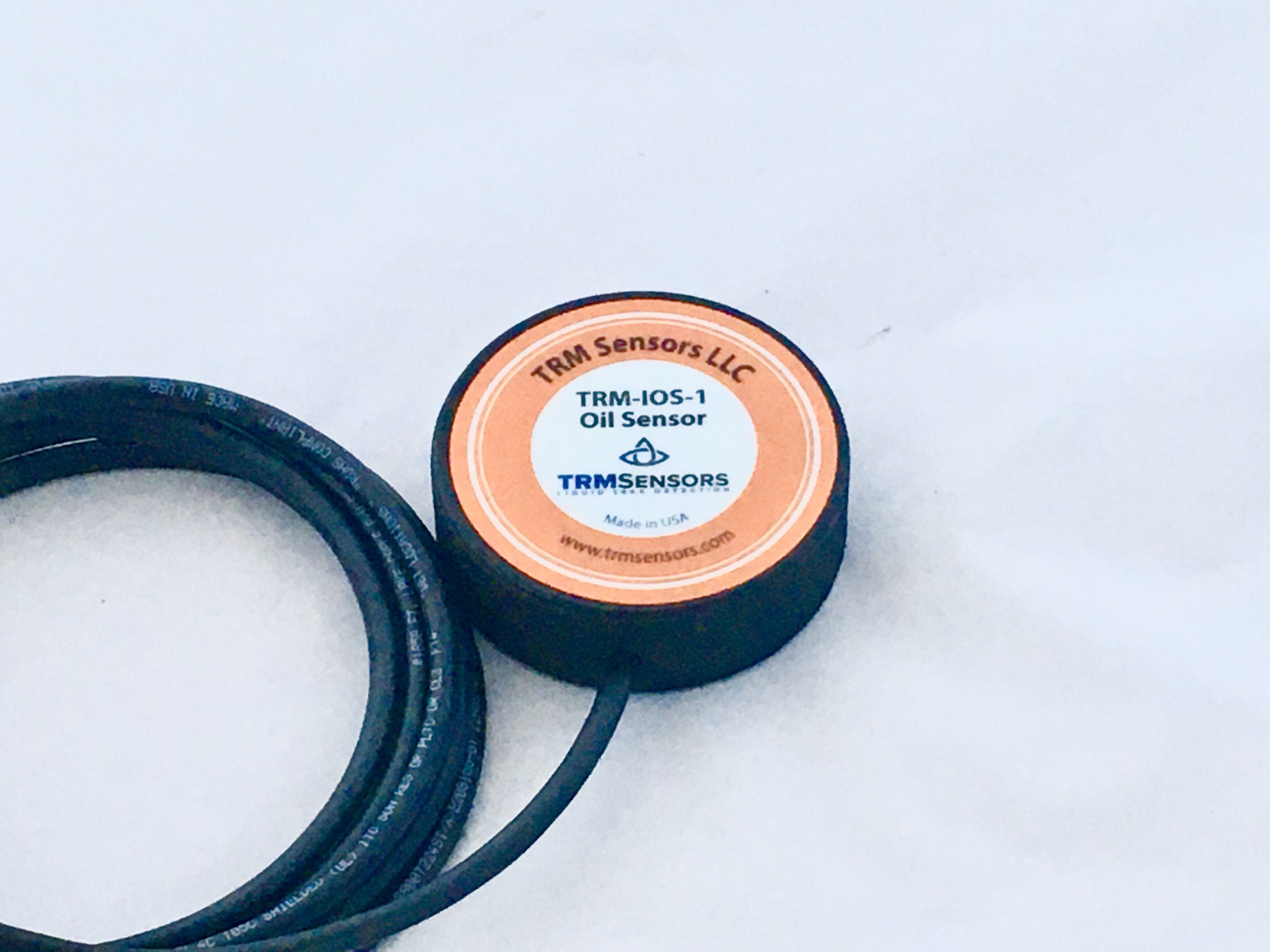
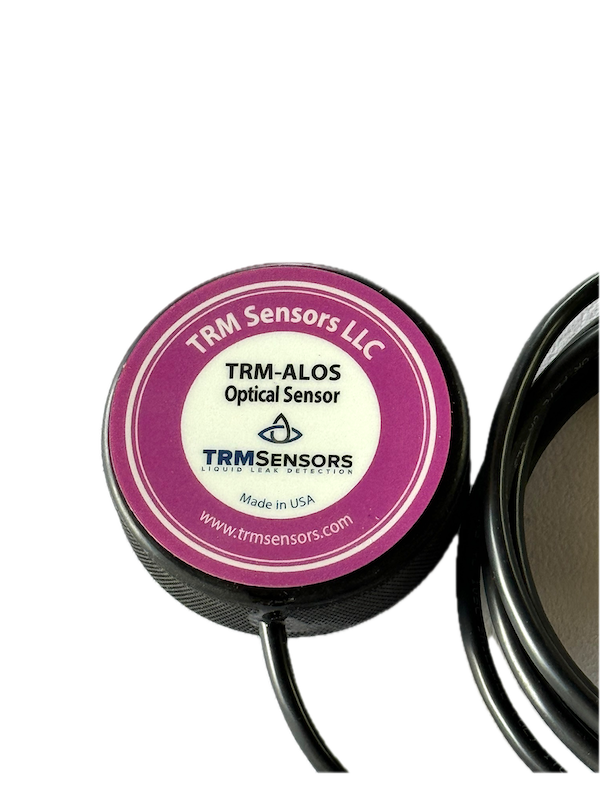
Example Scenario: Diesel Generators
The fuel fittings on or adjacent to a diesel engine are potential leak sources. Spin on fuel filters and flex hose couplings are frequently cited as the source of leaks and spills. TRM Sensors offers a unique low profile “hockey-puck” style sensor designed to detect a puddle of diesel fuel on a flat surface. TRM-DFS-3 is a wired sensor that generates alarms signal via traditional alarm system inputs or directly to BMS dry contact inputs. Both “normally open” and “normally closed” versions are available. Most installations use multiple hockey-puck sensors that are placed on the concrete floor or in drip pans below the potential leak sources. The sensor element is held flat on the floor surface by the weight of the sensor body so even the shallowest puddle of fuel spreading across the floor surface is detected quickly. Response time is just a few seconds once the fuel contacts the sensor element.
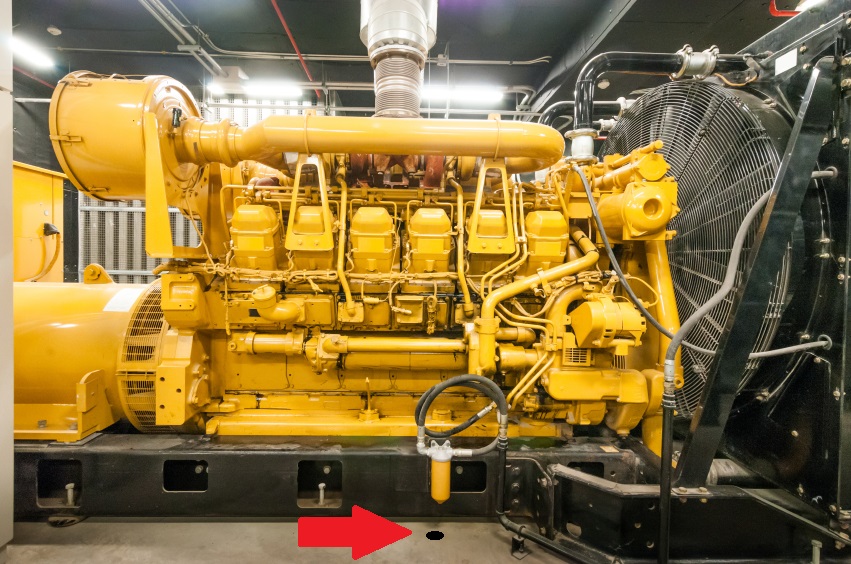
Example Scenario: Day Tanks
Day tanks for emergency generators and diesel powered fire pumps store the largest quantity of combustible fuel in the building. Small amounts of water in the fuel can settle to the bottom of the tank and can cause corrosion and eventual leakage. Tanks will have fill lines, vent lines and discharge lines with pumps and valves. Tanks may be equipped with containment shells, partial or complete drip pans or no containment at all. Place TRM-DFS-3 on the floor or in the drip pan at the low end of the tank and beneath valves and pump fittings. More than one sensor may be needed.
Example Scenario: Hydraulic Elevator Put and Pump Room.
Several TRM-ALOS optical based leak sensors can be deployed in the pit and nearby pump room. The :hockey puck style ALOS sensor scan be secured to the floor using TRM-DFS-3-SSHD hold down clips, then daisy chained back to a aTRM-Wall Alarm mounted in the equipment room. Water or oil collecting in the pit floor or a hydraulic tank leak in teh pump room will trigger an alarm response (LED / Buzzer ) at the wall alarm location and relay contacts built into the Wall Alarm can be used to signal the BMS or other alarm monitoring equipment
